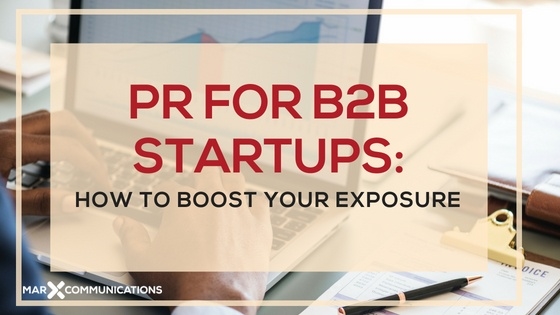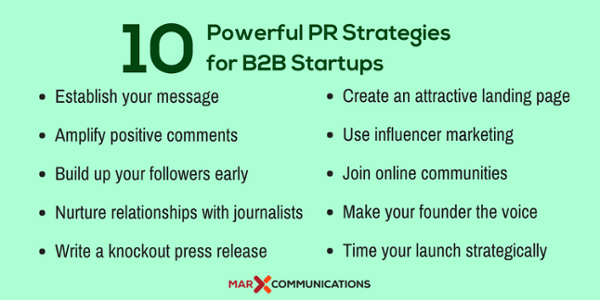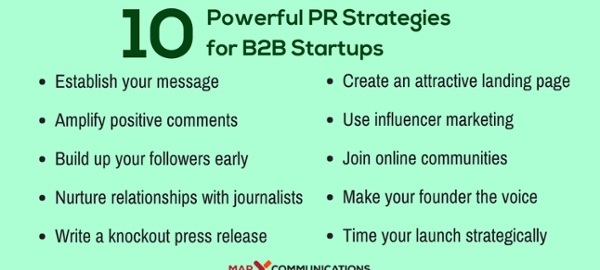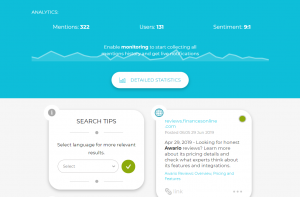— July 10, 2018

Is PR for B2B startups really necessary? While you may think that you have the stand-out ideas and product to ensure startup stardom, let’s consider a couple facts… Every year, around 100 million startups are launched throughout the world. Of that number, it is estimated that a little over 50% fail in the first four years.
Does this mean that failure is inevitable? Hardly!
Sometimes all it takes is knowing the right PR strategies for startups to get your business the exposure to catapult you to success.
Why PR Is Important for Startup Success
PR has made a big difference for many budding businesses. Consider just a few ways that you can use PR to help your startup inch ahead of the pack.
Enhance your credibility. Reputation is an important component of success for any startup. PR helps you to create the kind of insightful content and media exposure that earn you a reputation as an industry expert.
Give your brand a voice. Initially, it can be hard to nail down a unified voice for your brand. PR helps you to create a consistent voice and messaging to help shape your brand and share it with your target audience.
Generate awareness. Awareness is not simply the fact that people know you exist. You want people to talk about you and understand that you’re different from your competitors. PR helps to spark conversations around your brand and create the best kind of awareness.
Whether you decide to use the expertise of a PR firm that helps B2B startups or handle your PR in-house, public relations is a key way to rock your startup launch. But what PR strategies for startups should you use?
Let’s now look at 8 incredible PR secrets for startups that will launch you from anonymity to startup stardom.
8 Powerful Ways to Rock PR for B2B Startups
1. Establish Your Message
Before you do anything else, it’s time to sit down and determine your message. There are a few questions you need to answer in order to nail down your message. These include:
- What are you?
- What do you do?
- What problems do you solve for your target demographic?
- What makes you different from your competitors?
- Why should people care about your brand?
These questions are especially important if you’re entering an already crowded space. You need to differentiate yourself from your competitors and help your audience see how you are different.
Create a messaging document that clearly spells out your key messages and positions, including how you differentiate yourself from your competitors.
It can be difficult to create a message that resonates in the B2B space — let’s face it, B2B can get complicated, even for seasoned veterans. But you need to simplify it. For example, if your product or service has 20 different functions, mentioning them all will overload your audience. Narrow it down to one key item that covers it all. Simplifying your message doesn’t make your startup less important. It just makes it shine brighter.
Your story is what gets people excited. Think back to Apple’s message when it launched its first iPod. Steve Jobs uttered those famous words: “1,000 songs in your pocket.” It was succinct, but also made a powerful point. Jobs didn’t have to say that there was nothing like it on the market or present an exhaustive list of features — those five words said it all!
Simplifying your message doesn’t make your startup less important. It just makes it shine brighter.
2. Share Positive Comments
Comments are inevitable for every company, whether they’re new or old. But a secret to startup success is publicizing those comments. Whether it’s a comment you received in an email or on social media, use it to spread the word about your company.
You can talk about your brand until you’re red in the face — it will only get you so far. On the other hand, when a third party drops a positive review or comment about your brand, it will push it ten times further.
Why is this so effective? People are naturally distrustful of anything remotely self-promotional or salesy. They look for reviews from impartial third parties to influence their decision. This is why influencer marketing works so well (more on this in a little bit). If you can’t afford influencer marketing yet, look for and share other people’s comments.
A great, free tool to help you do this is Google Alerts. Set up an alert for your company name, your personal name, and anything else that identifies your brand. Once you’ve set this up, you will receive an alert when anybody mentions you or your brand online. Post them on your website and social media to provide social proof to potential customers.
3. Build an Early Follower Support System

Support is crucial in those early startup years. It is important to have a solid base of followers at the ready before you even pull that launch trigger.
A great tool to help you find new followers is social media. Choose networks where your target audience lives — for many B2B companies, this means Twitter, LinkedIn, and Facebook.
Take to your social networks to talk about your brand and any upcoming products and services you plan to launch. This will fuel excitement. Those who are interested will follow you to keep up with details. More importantly, they will be there when you’re ready to launch. Use the full range of social features, such as live video or contests, to engage your audience in your brand.
Another way to promote your brand and increase your followers is to guest blog. What blogs in your niche have a large following? What kinds of blogs does your ideal audience read? Once you’ve found one that takes guest bloggers, craft a post that will showcase your expertise and boost your credibility. Link to your startup’s webpage in your bio to make it easy for people to find you.
4. Build Relationships with Journalists
Journalists are your key to press coverage. In reality, in every industry there are a swarm of people that compete for a journalist’s attention. How can you be heard with so much noise? How do you stand out?
It all begins with a relationship. You should begin cultivating this relationship around six months before you launch. The key to this relationship is being helpful. Forget about what you need. Offer journalists stories that will excite their audience and serve their needs, not your own. Like, retweet or comment on their stories. Like everyone, journalists appreciate recognition.
This helps you to build a relationship. Then, when you’re ready to launch, you already have a rapport with which to work. Once you find a journalist whose beat fits your industry, do your research to find out what kind of stories the reporter covers. What stories did his or her audience like and share the most on social media? Use this information to craft your own pitch.
If this is too overwhelming or you don’t have enough time to cultivate these relationships, then it would be a good idea to hire a PR firm who already has established relationships with the media.
5. Write a Knockout Press Release
Press releases, while often pooh poohed, are a helpful tool to explain your story. Don’t approach your press release as a sales pitch — it will just annoy journalists. Instead, tell a story that shows the journey that your startup has taken and why it’s important. Storytelling is an important part of your press release strategy — it captivates the attention of journalists and shows them how timely and effective your news is.
There are a few must-have components to any press release. These include:
- A press release headline that absorbs your audience and makes them want to know more.
- A quote from an executive within your company that will humanize your brand and breathe some life into your release.
- Multimedia, such as images, infographics, and videos, that will hold the attention of your reader.
- A call to action to learn more.
Don’t send your press release to the world but to a few journalists along with a note explaining the gist of your story. Or consider simply sending a note and then asking the journalist if he or she would like to see a
6. Create an Attractive Landing Page
Don’t let potential customers fall through the cracks. If their interest wanes, you run the risk that they will move on to one of your competitors. Collect their contact information with a landing page so that you can invite them back once your new product or service goes live.
What makes an attractive and effective landing page? Here are a few points to keep in mind:
- Don’t overload it with useless information.
- Keep it simple and to the point, with a clean design.
- Include your logo and at least one image to engage visitors.
- Use action words and language that motivates your audience.
Keep your form simple as well — if you ask for too much information, it may scare your visitors away. If possible, limit the information to name and email address.
You’ll learn how many people are interested in your product or service and you’ll have a way to reach out. Send periodic emails updates on your progress pre-launch — and, most importantly, get people stoked for it. Nurture any interest into serious leads and customers.
7. Tap Into the Power of Influencer Marketing
Third party approval can be key in customers choosing one brand over another. Especially as a startup, it’s important to have as many on your side as possible, including influencers.
How does influencer marketing work? Find an influencer that fits your industry, and who your target audience turns to for advice and insight. While some believe that the perfect influencer must have the largest following possible, that’s far from the truth. Micro-influencers (who have around 15,000 followers) are fast rising in popularity as the more effective choice. This is because their followers are often more loyal and more likely to heed their advice.
How do you use an influencer? One option is to have an influencer beta test your product or service. If the influencer gives it a glowing review, use the review to add credibility to your brand and expand your reach. Naturally, with the influencer’s OK. If there are things the influencer dislikes about your product or service, use the feedback to improve your offer and get it ready for the final launch. The influencer will appreciate that you took his or her feedback to heart.
Other ways to work with an influencer include collaborating on content, having the influencer guest post or conduct an interview or webinar with the influencer. Don’t be afraid to think outside the box and create your own influencer marketing strategy to drive your startup to the top.
8. Find Online Communities to Join
Hundreds of online communities in every imaginable niche exist. Join every community that touches on your niche, whether this is on LinkedIn, Google Plus, Quora, or another community-based site.
Once you’ve joined this community, avoid shameless self-promotion. Instead, add meaningful comments to conversations and post relevant material that community members will enjoy.
Once you’ve established yourself as a helpful, thoughtful person, casually mention your startup, what makes you different, and the benefits of your upcoming launch.
9. Make Your Founder Your Star
People want to see the woman or man behind the startup. The person who conceived the startup, obsessed over it in sleepless nights, and invested blood, blood, sweat, and tears to get it off the ground.
Your founder needs to be on the frontlines of your company — making announcements, writing blogs, getting in front of your company. If you assign another member of your team, even one you believe is better suited to the limelight, it will only come across as insincere and even fraudulent.
The more involved your founder is in every step of your startup’s public relations, the more genuine your launch will appear. That’s what the media, as well as your target audience, wants to see.
Take the extra step and give your founder the media training he or she needs. A launch comes with interviews, appearances, and statements. You’re in the last leg of the race — you don’t want a little slip up to ruin all your hard work.
10. Time Your Launch Carefully
You can get every other detail of your launch spot on, but all of that work could be for naught if you don’t time it properly.
For starters, don’t start creating buzz around your product or service too early. If you do, you run the risk that your audience will lose interest and move on to something else. When you finally do launch, they will have forgotten all about you.
On the other hand, if you put these strategies into place a mere week before your launch, you won’t have time to gain the traction you need.
Ensure your launch doesn’t coincide with any major holidays, events, natural disasters, or big news. For example, if you hear that tech giant Apple is poised to launch a new product at the same time as your tech startup, then it’s time to rework your timing.
Lastly, get your product or service is locked down and in tip-top shape before you launch. Do beta testing and get experienced third parties involved to confirm that every aspect of your offer is ready for the scrutinizing public eye.

Whether you go it alone or use an experienced PR firm that helps B2B startups, PR can make a big difference in the success of your startup. Use these PR strategies for startups to grow your business and get killer exposure for your brand.
Business & Finance Articles on Business 2 Community
(74)







